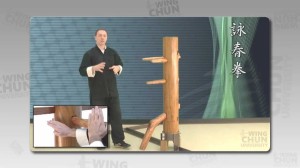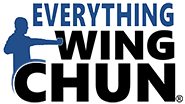After watching Sifu Wayne Belonoha’s series on Wooden Dummy training in Wing Chun University, I had a few questions regarding how to train on the wooden man. Sifu Wayne granted me this interview and below you will find a wealth of information about wooden dummy training.
Although you have explained many of these details in your video, what would say some of the most important things you learn from the dummy? From beginner perspective? From an advance perceptive?
 First let me take a minute to thank you for offering to interview me. I appreciate the opportunity.
First let me take a minute to thank you for offering to interview me. I appreciate the opportunity.
In our system, the wooden dummy is taught after the siu lim tau, chum kiu, and biu ji forms. We believe that the dummy contains movements and concepts introduced in these earlier forms so it seems reasonable that the dummy training be held off until the student is proficient in those movements.
Because I was taught the dummy after biu ji form, I can only speculate on the advantages and disadvantages of training the dummy earlier than I learned it. I hope that’s okay.
Even though that’s the way I was taught, I still did my own assessment to see if it was more valuable to teach the dummy earlier. There is an entire field of andragogical study that attempts to refine curriculums with the goal of maximizing the efficiency of adult learning; and although I am not an expert I do have some experience in this field – implementing (or installing) adult learning systems for development and performance improvement professionally. Experience has shown me that there are a number of high level skills to be learned with the dummy; that it’s not just a rough bludgeoning tool. My experience, backed by the teachings of Rosenstock-Huessy and Knowles, has led me to believe that teaching a complex or fine motor skill competency, and energy exercises, before a student has the foundational competencies in place is not optimal.
Now there are a few reasons, such as motivation, that one might want to show advanced concepts early, however andragogical theory dictates that the student is already motivated.
In layman’s terms – I believe it’s important to walk before you run. I believe the wooden dummy is able to teach a person to run. That’s my reasoning for why I don’t teach the dummy before biu ji. Let me clarify with some concrete examples…
When I learned the wooden dummy, it helped me to refine my techniques. It acted like a very fine grit sandpaper, smoothing out the smallest rough edge. It helped me with my accuracy and positioning, it helped get my elbow more on center, it helped me to be able to release energy, and it improved the flow of my techniques, it gave me a physical opponent against which I could apply my already stable techniques. It improved my already trained structure. It further fine-tuned my timing; and this is the short list.
I don’t think the wooden man has much to teach the beginner. However to the advanced student with the training to recognize subtle differences in timing, power, distance, balance – there are many lessons to be learned from this stationary and patient teacher.
In the video you talk about softness, can you please explain what softness is in Wing Chun? I often wonder if people take “softness” too far and are more like a soft noodle then relaxed & present in their movements.
I believe that relaxation does not mean the absence of all tension; when I talk about relaxation I mean the absence of unnecessary tension. To be without unnecessary tension is to be in an active alert state, sensing and being aware of the environment. When I think about things that have eliminated unnecessary tension, I think about the stalk of bamboo or perhaps a cat. Neither are so relaxed that they become limp but they also are not rigid or bound up – they both allow their structures to support their movements and are efficient in the way they do so.
When a person has a poor posture or poor position, they naturally apply more muscle power then necessary to hold that position. It’s important for a person to train enough that this relaxed state becomes second nature. There is an old adage which states “conscious relaxation will unconsciously produce force”.
Being the “soft noodle” is one method of fighting and has its merits. However, I believe that if the noodle is too soft, it does bring with it some disadvantages. I advocate maintaining relaxed muscles by using the body’s structure for support.
In your course you speak about taking it easy on the dummy, don’t hit too hard, and really worry about the details. At one point you say “put some energy into the dummy but not a lot.” When, if ever, is it appropriate to work your way up and really try and put some power into your movements?
The first phase of learning the dummy form is to learn proper technique and positioning. By doing proper technique one will learn when the elbows leak energy, when the techniques are off center, how to remain facing the shape, proper distance and when the timing is not correct. Without proper positioning / distance, proper techniques will be difficult, as will the transition to the next move in the form.
Once the technique and positioning are correct, the student can start to release energy. It should be obvious the types of problems that can arise if a student tries to release energy or use full-body power when the techniques, structure and position are wrong.
In the video you use a free standing dummy. Compared to a Mounted Dummy, do you feel one is better then the other? What are the differences?
The choice to use a free standing dummy for the videos was pragmatic. I wanted to give people a clear view of the techniques and it was difficult when the dummy was mounted so close to the wall. The trade off was that I couldn’t put as much power into some of the techniques as I wanted, but “them’s the breaks” as they say.
Overall, my preference is to have a dummy mounted to the wall with cross slats which give some springiness. Next is to have the “dead” dummy – where the bottom part of the dummy is mounted into the ground, and finally the free standing version.
Though out the video you speak a lot about visualizing. Aside from the combinations and attacks to defend you explain, is there anything else we should be thinking about?
When doing the dummy I typically think about a nice MLT – mutton, lettuce and tomato sandwich. Oh wait, no, that’s when I’m getting ready to storm a castle.
Seriously though, there are a couple of different “modes” for me when I play the dummy depending on what I am training at the time.
First is my technical way to play. I take it a bit slower, I issue some energy but not a lot – I seek technical perfection and refinement of each technique. I want each movement to be in precisely the right spot and position. My techniques do not include much power or fa jing, but precise body structure and mechanics. I train to stretch and keep the elbows in; my kicks are a bit higher and held a bit longer to train my balance.
Then there is the “flow” way, the fighting way. I don’t really think that much about the attack and defend combinations. The vast majority of the time I think about what energy I’m giving to the dummy. When I do this, I don’t think about this technique or that – I think about “If somebody saw me doing this, could THEY imagine my opponent.” I sink my stance, my movements are more connected and powerful (whether I issue power into the dummy or not). I am intensely focused on my opponent and I want people to know that this is a fighting form. I think about delivering relaxed power and have a good combination of slowness, power and explosiveness, and then stillness – where I relax and gather. During the stillness parts of my form I practice (and try to demonstrate outwardly) the relaxed awareness we talked about earlier. My form becomes a fighting symphony. In this mode of practice, I focus on letting my heart (Yi) lead my mind, which leads my actions. The focus on the fighting energy puts me in “flow” mode – where I experience the perfect instant. Through the flow state flow state from this form (in particular) I work on becoming more autotelic.
In the video I assume you teach Moy Yat’s version of the dummy. How does this linage different from others? Does it emphasize anything different?
First I’d like to clarify. Sunny Tang, who was taught by Grandmaster Moy Yat, who was taught by Grandmaster Ip Man, taught me. My teacher learned in Hong Kong with Grandmaster Moy Yat, and of course Grandmaster Ip Man. My teacher was also well known for his participation in the gong sau (street fighting) activities and therefore has a wealth of practical experience to share.
I say this to give some context to my lineage and therefore which version of the dummy I teach. My dummy form is the same as Moy Yat’s version of the dummy, yes – but to stop there and only say that would not be a complete story and leaves out the importance of what my teacher brought into the picture. In short, yes I teach the Ip Man / Moy Yat / Sunny Tang version of the dummy.
Having specialized in my lineage, I’m not that familiar with the dummy form of other lineages so I wouldn’t be a good person to ask about the differences. I enjoy collaborating and looking for similarities between lineages but haven’t had the opportunity to do so at a high level yet.
In your opinion, would it be totally inappropriate for a non dummy level person to train on the dummy?
I wouldn’t say it’s inappropriate because everybody has their own goals (including school owners).
I believe some school owners use the dummy as a motivational tool. I believe the school owners know the student wants to use it, for whatever reasons, and does not wish to wait 3 years. The school owners recognize the students’ desire and caters to it – I don’t follow this practice.
I personally believe adults should be mature and intrinsically motivated to improve and will recognize the true intent of allowing students to use an advanced tool too early. Naturally, for the beginner, there will be some value but I believe the time could be spent more efficiently. Ultimately, this tactic of allowing students to use tools that bring reduced value will show drawbacks – at some level the student knows the school owner’s training choices can be influenced by money or ego.
Additionally, I believe the simple things that the dummy can teach a beginner become pretty insignificant when compared to the other higher level concepts of flow and energy play. I therefore lean towards letting the other forms teach the basic techniques and once the student is ready to start “putting it all together” they can start working on the dummy.
Order before July 31, 2013 and Save 15% on any of Sifu Belonoha’s dummy videos with Coupon Code: WCUdummy
Want to read more Wing Chun interviews? Click Here to Check Out More Interviews

